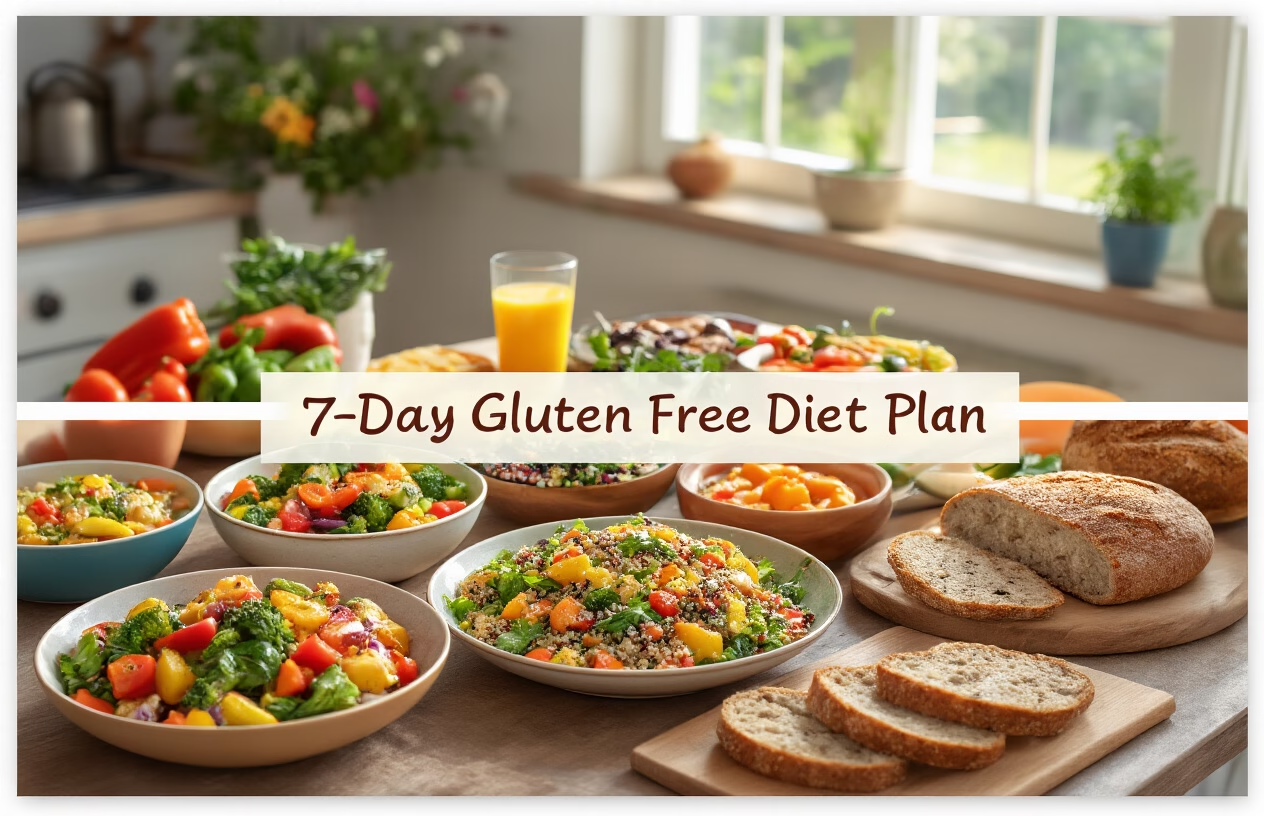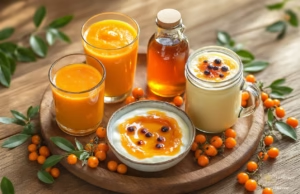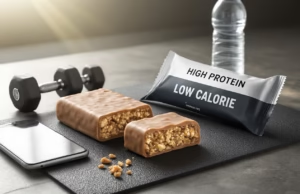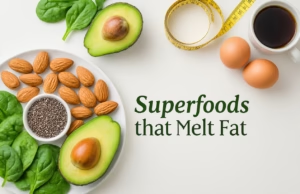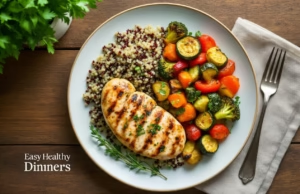Ever stared at your pantry after a celiac diagnosis, wondering if you’ll ever enjoy a decent meal again? Trust me, I’ve been there—and that feeling of food-future-dread is completely normal.
But here’s the truth: going gluten free doesn’t mean sacrificing flavor or variety. This 7-day gluten free diet plan is designed specifically for beginners who want to transform their health without living on bland rice cakes and sadness.
In just one week, you’ll discover how simple swaps and smart meal planning can revolutionize your relationship with food. No more accidental glutening. No more awkward restaurant moments. Just delicious, satisfying meals that happen to be gluten free.
Ready to see how Monday’s breakfast alone might change your entire perspective on this journey? The meal ideas for gluten free diet plan…
Subscribe for good and useful information.
Understanding Gluten and Its Effects on Health

A. What is gluten and where is it found?
Gluten is a protein found in wheat, barley, and rye that gives bread its chewy texture and helps it rise. It lurks in obvious places like pasta and bread, but also hides in surprising products like soy sauce, salad dressings, and even some medications and supplements.
B. Common symptoms of gluten sensitivity
Stomach pain, bloating, and diarrhea might be your body’s way of saying “no thanks” to gluten. But gluten sensitivity goes beyond just tummy troubles. Brain fog, headaches, joint pain, skin rashes, and constant fatigue are all red flags that your body might be fighting gluten with every bite.
C. Health benefits of going gluten-free
Ditching gluten can be a game-changer for the right people. Beyond the obvious relief from digestive distress, many report clearer thinking, higher energy levels, less inflammation, and better sleep. Your skin might clear up too, and those mystery aches and pains? They could vanish once gluten exits the building.
D. Who should consider a gluten-free diet?
Celiac disease folks? Absolutely. But you don’t need a diagnosis to try gluten-free. If you’re battling unexplained symptoms, autoimmune issues, or chronic inflammation, cutting gluten might be worth a shot. Just remember – don’t self-diagnose. Chat with your doc before making the leap.
Essential Gluten-Free Pantry Staples

A. Grains and flours that are naturally gluten-free
Rice, quinoa, millet, and buckwheat are your new best friends on a gluten-free journey. Don’t forget about amaranth and teff – these ancient grains pack a nutritional punch. For baking, stock up on almond flour, coconut flour, and certified gluten-free oat flour to keep your favorite recipes possible.
B. Protein sources for a balanced diet
Loading your pantry with protein is crucial for staying satisfied. Canned beans, lentils, and chickpeas offer convenience and versatility. Nuts and seeds provide portable protein options. Don’t skip animal proteins like eggs, canned tuna, and frozen chicken breasts – they’re naturally gluten-free and perfect for quick meals.
C. Healthy fats and oils
Good fats make gluten-free foods taste amazing. Extra virgin olive oil works for everyday cooking, while avocado oil handles high-heat situations. Coconut oil adds tropical flavor to baked goods. Keep nuts, seeds, and avocados on hand for snacking and meal-topping to ensure you’re getting those essential fatty acids.
D. Herbs, spices, and condiments for flavor enhancement
Gluten-free eating is anything but bland when your spice rack is properly stocked. Pure herbs and spices transform simple dishes into crave-worthy meals. Gluten-free tamari replaces soy sauce, while apple cider vinegar and dijon mustard (check labels!) create amazing dressings. Fresh garlic and ginger are non-negotiable flavor boosters.
Meal Prep Strategies for Gluten-Free Success

Weekly shopping guide
Planning is your secret weapon for gluten-free living. Hit the store with a detailed list organized by aisles. Focus on naturally gluten-free foods like fresh produce, unprocessed meats, and certified gluten-free products. Stock up on staples like rice, quinoa, and gluten-free flours to minimize emergency shopping trips.
Time-saving preparation techniques
Batch cooking will revolutionize your gluten-free lifestyle. Dedicate a few hours on weekends to prep basics like brown rice, quinoa, and roasted vegetables. Pre-chop veggies, portion proteins, and assemble meal components in containers. This front-loaded effort means you’ll have grab-and-go options all week long.
Storage solutions for gluten-free ingredients
Proper storage prevents cross-contamination and extends shelf life. Invest in airtight containers for flours and grains—they’re not just pretty, they’re practical. Label everything clearly with purchase dates. Store gluten-free items on upper shelves, away from regular flour products that might sprinkle down.
Cross-contamination prevention tips
Cross-contamination can wreck your gluten-free efforts. Dedicate separate cutting boards, colanders, and toasters exclusively for gluten-free use. Clean counters thoroughly before prep. Always check utensils, especially wooden or plastic ones that might harbor gluten particles. When in doubt, wash twice.
Day 1: Energizing Breakfast and Protein-Packed Meals

Day 1: Energizing Breakfast and Protein-Packed Meals
A. Quick morning options that fuel your day
Starting a gluten-free journey doesn’t mean bland breakfasts. Whip up some coconut flour pancakes topped with fresh berries, or try overnight chia pudding with almond milk. Need something faster? Grab a banana and natural peanut butter, or blend a quick smoothie with spinach, frozen fruit, and protein powder. These options kickstart your metabolism without the gluten crash.
B. Satisfying lunch ideas
Ditch the sandwich rut with vibrant alternatives. Try mason jar salads layered with quinoa, roasted veggies, chickpeas, and homemade vinaigrette. Lettuce wraps filled with tuna or chicken salad make a protein-rich option. For something warm, heat up a bowl of hearty vegetable soup with brown rice. These lunches keep you full without that mid-afternoon slump.
C. Dinner recipes that the whole family will love
Family dinners just got easier with these crowd-pleasers. Baked salmon with lemon-dill sauce alongside roasted potatoes and asparagus makes an impressive yet simple meal. Try Mexican-inspired stuffed bell peppers with ground turkey, black beans, and rice. For pasta night, use gluten-free noodles in your favorite dishes—most family members won’t even notice the switch!
D. Smart snacking choices
Keep hunger at bay with strategic snacks. Apple slices with almond butter provide the perfect sweet-savory combo. Rice cakes topped with avocado and everything bagel seasoning satisfy crunchy cravings. Make a batch of energy balls using dates, nuts, and chocolate chips for sweet tooth emergencies. Pre-portion trail mix with nuts, seeds, and dried fruit for grab-and-go fuel.
Day 2-3: Exploring Global Cuisines Without Gluten

Day 2-3: Exploring Global Cuisines Without Gluten
A. Mediterranean-inspired dishes
Going gluten-free doesn’t mean bland eating. Mediterranean cuisine naturally embraces gluten-free ingredients like olive oil, fresh vegetables, and lean proteins. Swap regular pasta for chickpea alternatives in your Greek salad, or try eggplant-based moussaka instead of traditional versions. These dishes deliver all the flavor without the gluten.
B. Asian flavors made gluten-free
Think Asian food is off-limits? Think again! Rice noodles make perfect pad thai, while tamari easily replaces soy sauce in stir-fries. Try cauliflower rice for sushi rolls or lettuce wraps instead of dumplings. The umami flavors you crave are totally doable on a gluten-free diet.
C. Mexican and Latin American options
Mexican cuisine is a gluten-free goldmine! Corn tortillas (not flour) make authentic tacos and enchiladas. Load up bowls with rice, beans, grilled meats, and fresh salsas. Plantains, yuca, and quinoa offer satisfying alternatives to wheat-based sides while keeping all the bold flavors intact.
D. Comfort food classics reimagined
Missing pizza and pasta? Cauliflower crusts and gluten-free flours have revolutionized comfort food. Zucchini noodles tossed with homemade pesto satisfy pasta cravings, while almond flour biscuits with gravy bring back breakfast favorites. You won’t even notice what’s missing!
Day 4-5: Nutrient-Dense Recipes for Optimal Health

Incorporating superfoods into your meals
Days 4-5 are all about nutrient powerhouses. Think quinoa bowls topped with avocado, blueberries, and pumpkin seeds. These aren’t just trendy foods—they’re gluten-free nutritional goldmines that actually make you feel amazing. Pack your plate with color and watch your energy soar without a speck of gluten in sight.
Balancing macronutrients for sustained energy
Getting your protein-carb-fat ratio right is the secret weapon for steady energy. Combine sweet potatoes with grilled chicken and olive oil drizzle. Or try chickpea pasta with pesto and pine nuts. These balanced combos prevent those mid-afternoon crashes that send you hunting for snacks. Your body will thank you.
Veggie-forward dishes that satisfy
Vegetables aren’t just side dishes anymore. Cauliflower rice stir-fry loaded with colorful peppers and snap peas brings serious satisfaction. Stuffed portobello mushrooms with herb-flecked quinoa feel indulgent yet light. These veggie stars prove gluten-free eating is anything but boring. Your taste buds won’t miss a thing.
Bone-building calcium sources beyond dairy
No gluten, no dairy, no problem. Calcium-rich alternatives like almond milk, sardines, and chia seeds keep your bones strong. Leafy greens like kale and bok choy deliver calcium without the digestive issues some face with dairy. These foods support your skeleton while keeping your gluten-free journey deliciously varied.
Day 6-7: Weekend Indulgences and Social Situations

Day 6-7: Weekend Indulgences and Social Situations
A. Gluten-free baking fundamentals
Mastering gluten-free baking isn’t rocket science. Mix your flours—try almond, rice, and tapioca for best results. Xanthan gum is your friend, adding that missing elasticity. Room-temperature ingredients blend better, and don’t overmix your batters. Start with simple recipes like cookies before tackling bread. Trust me, nobody will taste the difference.
B. Dinner party menu ideas
Hosting friends? Wow them with a gluten-free feast they won’t even recognize as “special.” Start with loaded nachos using corn chips. For mains, go with naturally gluten-free dishes like herb-roasted chicken, potatoes, and roasted vegetables. Finish strong with a flourless chocolate cake that’ll have everyone begging for your secret. The trick? Don’t announce it’s gluten-free until after they’ve raved about it.
C. Restaurant dining strategies
Eating out doesn’t have to be a nightmare. Call ahead—seriously, it makes all the difference. Check menus online and have backup options ready. Ask specific questions about preparation methods, not just ingredients. Stick to naturally gluten-free dishes when in doubt (grilled proteins, vegetables, rice). And don’t apologize for your needs—restaurants want your business and repeat customers.
D. Alcohol options that are gluten-free
Good news: not all booze is off-limits! Wine is your safe bet—red, white, sparkling, all good. Most distilled spirits like vodka, rum, and tequila are fine too, even if made from wheat (distillation removes gluten proteins). Watch for flavored varieties with added ingredients. Beer lovers, seek out options brewed from sorghum, rice, or millet. Always double-check ciders for malt additions.
Tracking Your Transformation

Physical changes to expect
When you ditch gluten, your body responds in amazing ways. That bloated feeling? Gone within days. Many people notice their skin clearing up, energy levels soaring, and those mystery headaches disappearing. The bathroom situation improves too—no more rushing to find the nearest toilet after meals.
Emotional and mental health improvements
The gluten-brain connection is real, folks. Brain fog lifts like morning mist, leaving you mentally sharper. Mood swings settle down, and that constant irritability? Vanishes. Many people report feeling genuinely happy again, not just surviving each day. Sleep quality improves too, giving your emotional health a serious upgrade.
Long-term health benefits
Stick with gluten-free living and you’re setting yourself up for some serious health wins. Inflammation decreases throughout your body, potentially reducing arthritis symptoms. Your gut heals, boosting nutrient absorption. Risk factors for autoimmune conditions may improve. The best part? Many people report fewer medications needed as their bodies find natural balance again.
Conclusion: Gluten Free Diet Plan
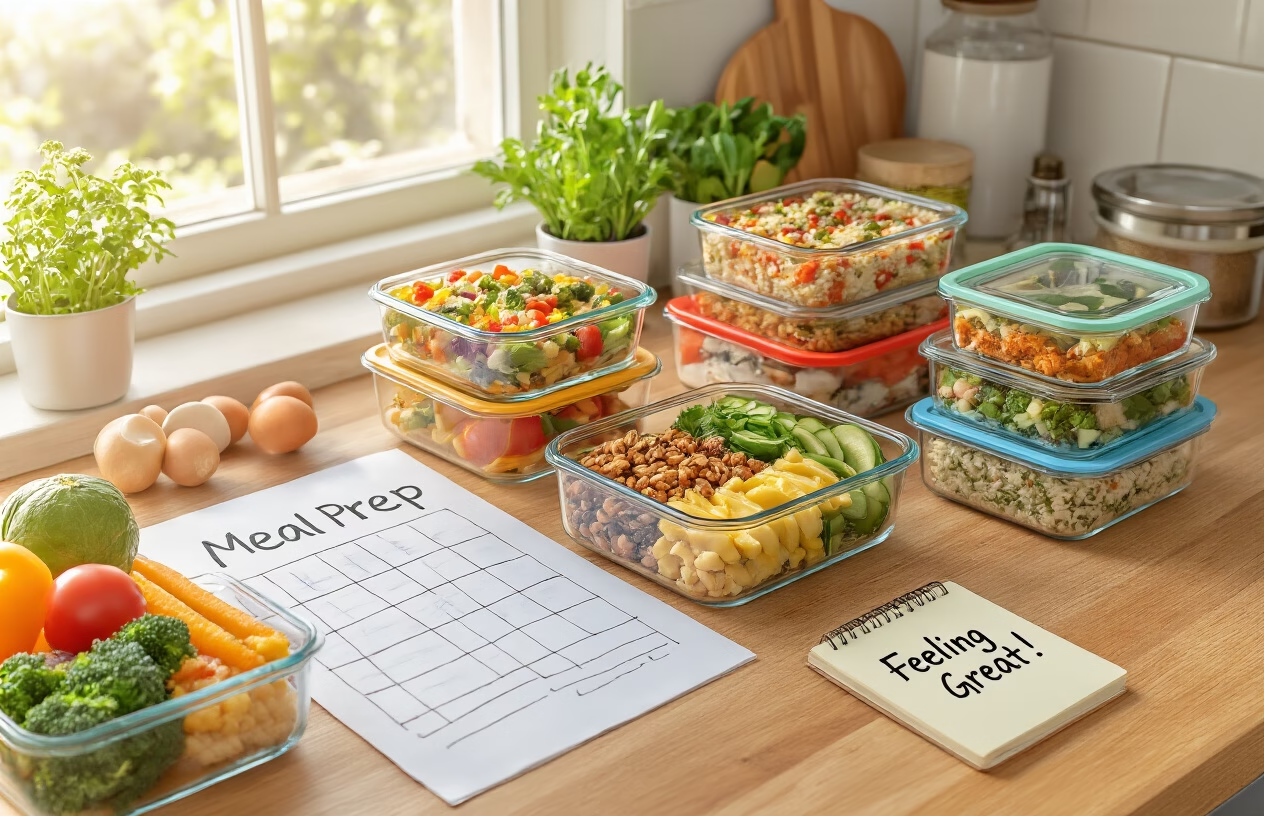
Embracing a gluten free diet plan lifestyle doesn’t mean sacrificing flavor or variety in your meals. With the right pantry staples, meal prep strategies, and diverse recipes spanning global cuisines, you can enjoy a nutritious and delicious diet while potentially improving your health. From energizing breakfasts to weekend indulgences, this 7-day plan provides a comprehensive roadmap for navigating a gluten-free lifestyle in all situations.
The meal ideas for gluten free diet plan, the gluten free diet plan, As you track your transformation, remember that going gluten-free is a personal journey. Listen to your body, adjust recipes to suit your taste preferences, and celebrate the positive changes you experience. Whether you’re managing celiac disease, gluten sensitivity, or simply exploring dietary options, the gluten-free path can be both healing and enjoyable when approached with creativity and knowledge. The gluten free diet plan are having Dietary restrictions.
#gluten free diet plan #gluten free diet plan #Dietary restrictions #Dietary restrictions #meal ideas #meal ideas #gluten free diet plan #gluten free diet plan #meal ideas #meal ideas #Dietary restrictions #Dietary restrictions
Follow Us On:
